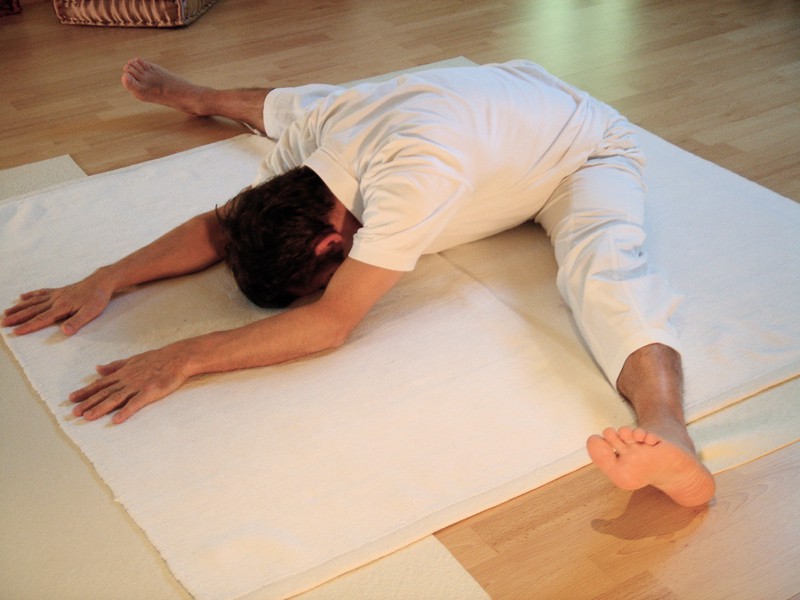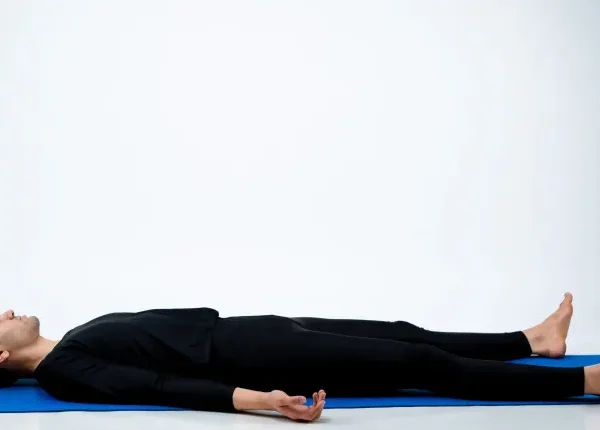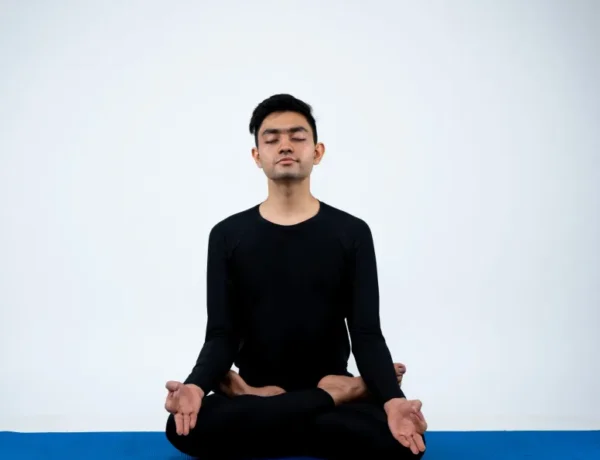Upavistha Konasana, commonly known as the Wide-Angle Seated Forward Bend, is a foundational yoga position with several physical and mental advantages.
This easy sitting forward fold offers the secret to greater flexibility, core strength, and inner calm. Let’s look at the substance of Upavistha Konasana, including its Sanskrit roots, appropriate technique, variants, advantages, and potential problems.
Table of Contents
ToggleThe Meaning of Upavistha Konasana.
Upavistha Konasana originated in traditional Hatha Yoga books such as the Hatha Yoga Pradipika and the Gheranda Samhita, where it is described as a sitting forward bend that stimulates the Muladhara (root) chakra.
The position is also described in Patanjali’s Yoga Sutras, which highlight the need for stable and comfortable sitting stances for attaining meditative states.
The term “Upavistha” means “seated” or “sitting,” but “Konasana” denotes an angle or extended side stretch. Together, they represent the posture’s fundamental elements: a wide-legged sitting stance and a forward bend.
Physiological Benefits of Upavistha Konasana:
- Enhanced Flexibility: Upavistha Konasana focuses on the hamstrings, groins, and hip flexors, progressively improving flexibility with persistent practice. Regular practice of this position can help relieve tension in the inner thighs and groins, improving general mobility.
- Strengthened Spine: As the practitioner leans forward, the spine gently extends, activating the muscles in the back and improving spinal health. This elongation helps to relieve tension accumulated from extended sitting or standing.
- Improved Digestion: Upavistha Konasana’s front fold allows for mild compression of the abdominal organs, increasing digestion and relieving discomfort caused by indigestion or bloating. This compression also stimulates the interior organs, which improves their function.
- Relief from Sciatic Pain: Upavistha Konasana relieves sciatic pain by extending the sciatic nerve and surrounding muscles. Regular practice frequently results in less pain and greater mobility in the lower back and hips.
- Calming the Mind: The contemplative quality of Upavistha Konasana, along with deep and aware breathing, promotes relaxation and calm. This posture allows practitioners to direct their attention within, which promotes mindfulness and mental clarity.
Energy and Spiritual Benefits of Upavistha Konasana:
In addition to its physical advantages, Upavistha Konasana has important energy and spiritual significance in the yoga tradition.
According to ancient yogic theory, this asana awakens the Muladhara chakra, located near the base of the spine and responsible for emotions of stability, security, and groundedness.
Upavistha Konasana promotes a sense of rootedness and connection to the earth by anchoring the body and directing energy flow to the root chakra, creating a solid foundation for spiritual growth.
Practice Guidelines:
Before performing Upavistha Konasana, the body must be fully warmed up to avoid injury and allow for deeper stretch. Dynamic exercises like hip circles, sitting twists, and forward folds can help prepare the muscles and joints for the intensity of this activity.
To perform the Upavistha Konasana:
- Begin by sitting on the floor, legs outstretched in front of you.
Open your legs to a comfortable distance apart, with your knees and toes pointing upward. - Engage the quadriceps to raise the kneecaps and flex the feet, ensuring an active and sturdy foundation.
- Inhale to stretch the spine; as you exhale, bend at the hips and fold forward from the pelvis.
- Maintain a long spine as you drop, leading with the chest and maintaining your shoulders relaxed.
- Place your hands on the floor in front of you, framing your body, or grab your shins or feet, depending on your flexibility.
Hold the stance for 30 seconds to 1 minute, breathing deeply and evenly. - Inhale and bring the torso back to an upright position, keeping the spine long.
- Exhale while softly bringing your legs together and returning to a sitting posture.
Modifications and variations:
For practitioners with low flexibility or mobility concerns, numerous adjustments and variations might make Upavistha Konasana more accessible.
- Use props: Place a bolster or folded blanket beneath the hips to raise the pelvis and relieve tension on the hamstrings and lower back.
- Bend the Knees: For novices or those with tight hamstrings, bending the knees slightly helps relieve strain on the lower back and allow for a deeper forward fold.
- Support the Torso: During the forward fold, use yoga blocks or a stack of cushions to keep the spine extended and the chest open.
Experiment with other arm variations, such as stretching your arms forward, putting your hands behind your back, or interlacing your fingers behind your feet, to deepen the stretch and target specific areas of tension.
Precautions and contraindications
While Upavistha Konasana has various advantages, it may not be appropriate for everyone, particularly those with specific health issues or injuries. Practitioners with the following difficulties should attempt this position cautiously or avoid it entirely:
- Hamstring or Groin Injury: People who have acute or chronic hamstring or groin muscle problems should avoid deep forward folds and instead do gentler stretches with a competent instructor.
- Lower Back discomfort: People who have pre-existing lower back discomfort or disc herniations should adjust the posture by bending the knees or using props to support the spine and avoid extending too much.
- Pregnancy: Pregnant women should exercise caution when doing Upavistha Konasana, avoiding deep forward folds and listening to their body. Consultation with a pregnant yoga instructor is essential to ensure safety and comfort while practicing.
Conclusion:
Upavistha Konasana is an effective technique for increasing physical vigor, mental clarity, and spiritual connection on the yoga mat.
This asana, with its stretching, strengthening, and meditative qualities, allows practitioners to investigate the complex interplay between body, breath, and mind.
Upavistha Konasana, whether done as part of a vigorous Vinyasa flow or a tranquil Hatha sequence, provides a pathway to comprehensive well-being by enabling practitioners to journey inside and find the profound knowledge that lives within.
Frequently Asked Questions
Upavistha Konasana, also known as the Wide-Angle Seated Forward Bend, is a yoga pose that involves sitting on the floor with legs spread wide apart and folding forward from the hips.
It is a foundational pose that stretches the hamstrings, inner thighs, groins, and hips while engaging the muscles of the back, abdomen, and pelvic floor.
It is often practiced as part of a warm-up sequence or as part of a cool-down sequence to release tension in the lower body. Benefits include increased flexibility, improved hip mobility, strengthened spine, relief from sciatic pain, stimulated digestion, and a sense of relaxation and calmness.
Upavistha Konasana, also known as the Wide-Angle Seated Forward Bend, is a yoga pose that improves flexibility, hip mobility, spine strength, digestion, and sciatic pain relief.
It promotes calming effects through deep breathing and meditation, and is believed to activate the muladhara chakra, promoting stability and groundedness. Regular practice can improve range of motion in daily activities and physical exercises.
Upavistha Konasana is a yoga pose that promotes physical and spiritual benefits. It promotes grounding, vitality, emotional release, mindfulness, and connection to the present moment.
It integrates the physical body, mental faculties, and spiritual essence, creating a harmonious union. This holistic approach leads to a sense of wholeness, unity, and interconnectedness with oneself, others, and the universe. Upavistha Konasana is a powerful tool for spiritual growth and self-discovery.
Upavistha Konasana is a pose that targets various muscles in the body, including adductors, hamstrings, quadriceps, hip flexors, spinal extensors, core muscles, and gluteal muscles.
By engaging these muscles mindfully and with proper alignment, practitioners can experience the full benefits of Upavistha Konasana while maintaining stability and integrity. By engaging these muscles, practitioners can experience the full benefits of this pose.





No Comments